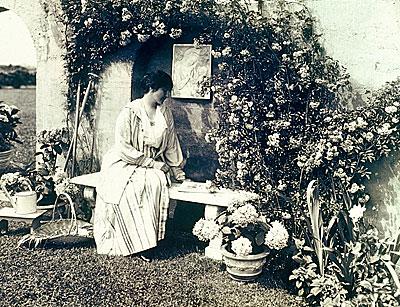Gardens Through a Photographer’s Lens

When one thinks of garden and landscape photography, it is often of color-saturated vistas and floral abundance. But when Leslie Rose Close gave a talk on Sunday afternoon about the history of garden photography, it was some time before the first color slide appeared, and the effect was jarring.
The richly tonal black-and-white images dating back to some of the first photographs by inventors and innovators of the field, such as William Henry Fox Talbot and early followers of Louis-Jacques-Mande Daguerre, were magnificent on their own, but the stories they told were just as remarkable.
Ms. Close, who trained as a painter and sculptor, earned a master’s degree at New York University, where her thesis was on Mattie Edwards Hewitt, a landscape and architectural photographer active from about 1909 until her death in 1956. She opened the talk, held at the Madoo Conservancy in Sagaponack, with Hewitt’s image of Anna Gilman Hill at Grey Gardens, a place Hewitt photographed extensively before Phelan and Edith Bouvier Beale bought it in 1924.
The photograph of a woman gardener by a female photographer in a garden designed by a female landscape architect, Ruth Dean (who was married to Aymar Embury, the architect of Guild Hall), showed the prominent role women were allowed to play in the field of garden design and photography in the early 20th century.
The discipline is so rich with characters and stories that it is no wonder that it has become an increasingly popular field of study within photographic history. Hewitt left her husband, Arthur Hewitt, who was also a photographer, to start a firm in New York with Frances Benjamin Johnston, whose photographs Hewitt had printed when she served as her husband’s darkroom assistant. They, too, had a falling-out eight years later and dissolved the partnership. By this point, however, Hewitt had enough clients and contacts to successfully strike out on her own.
Fox Talbot himself was an accomplished Renaissance man: a painter, botanist, and chemist, among many other things. He was one of the innovators of pre-digital photography, as we know it today, with negatives and paper prints. His book “The Pencil of Nature,” published in installments between 1844 and 1846, was the first commercially published book of photographs.
Ms. Close pointed out that the earliest images from cameras were of trees and plants, as a slide of one of Fox Talbot’s oak trees was shown. Paintings were still the preferred mode of reproducing a landscape. Photographs were seen as “scientific and not appealing, a tough sell.” But Fox Talbot recognized the potential for photography immediately, according to Ms. Close, who said he thought it was “a wonderful tool for travelers, artists, botanists, and historians. He got it exactly right.”
An image of the Crystal Palace from the Great Exhibition held in Hyde Park, London, in 1851, revealed the work of one of Daguerre’s followers, Baron Jean-Baptiste Louis Gros. The show featured industrial marvels, and the glass building enclosed a full-size elm tree. The image itself is a marvel, capturing the whole of the three-story tree and the exhibition space, along with statues, fountains, and other landscape features, all housed within the glass-and-steel edifice.
Other historical characters of note included Mary and Frances Allen, known as the Allen Sisters, from Deefield, Mass., who had their own colonial revival theme park around 1900, predating Old Sturbridge Village. The sisters would dress in period costume and do chores the way they were done in the 18th century. They would also take photographs of each other dressed in costume that they sold as souvenirs.
Ellen Wilmott, who died in 1934, was another intriguing figure. At an estate in Essex, England, from 1892 until her death, she employed 100 gardeners, sponsored some of the plant-hunting expeditions in the Far East and Middle East, and ended up with many varieties of plants named after her.
“She would fire a gardener at the sight of a weed in a flower bed . . . booby-trapped her gardens to prevent thieves, and was even known to carry a pistol.” Although Wilmott disdained photography, Ms. Close said that she was herself an accomplished garden photographer. It was a divide that would continue through the early 20th century.
Ms. Close said the subject is so broad and full that she could not cover its entire history. Still, she managed to tackle each decade of development in the field — regionally, nationally, and internationally. She showed images of and by figures such as Carleton Watkins, whose photos of the West helped preserve Yosemite National Park, as well as anonymously taken pictures of significant landscapes and people, such as Harriet Beecher Stowe, who was also a celebrated gardener.
Among the images of local gardens she shared were the Creeks in East Hampton before it was purchased by Alfonso Ossorio, and the great modernist landscape that Arthur Edwin Bye designed for George Soros in Southampton. Its mounds of earth echo the nearby beach dunes.
Ms. Close started a program in American landscape history at Wave Hill in the Bronx and co-founded the Catalog of Landscape Records in the United States, a database at the New York Botanical Garden. She has her own large food garden in Bridgehampton.
